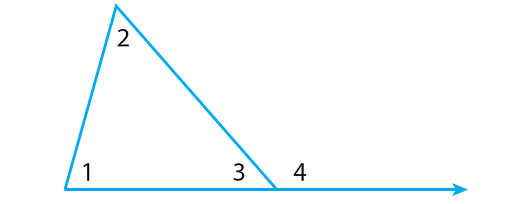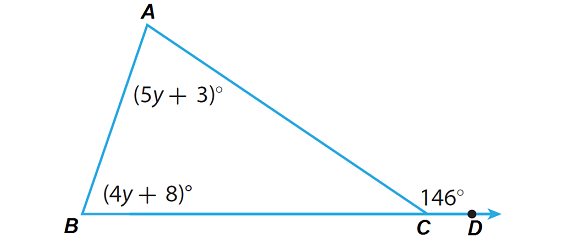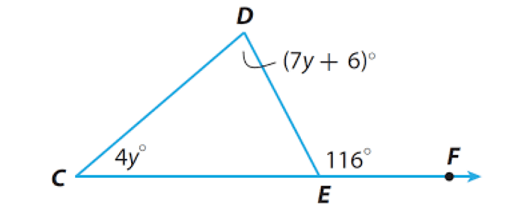USING THE EXTERIOR ANGLE THEOREM
Subscribe to our ▶️ YouTube channel 🔴 for the latest videos, updates, and tips.
This theorem is Proposition 1.16 in Euclid's Elements, which states that the measure of an exterior angle of a triangle is greater than either of the measures of the remote interior angles. This is a fundamental result in absolute geometry, because its proof does not depend upon the parallel postulate.
Exterior Angle Theorem

In the above diagram,
- m∠1, m∠2, and m∠3 are interior angles.
- m∠4 is an exterior angle.
- m∠1 and m∠2 are remote interior angles to m∠4.
The theorem states that the measure of an exterior angle is equal to the sum of its remote interior angles.
That is,
m∠1 + m∠2 = m∠4
Solved Problems
Problem 1 :
Find m∠W and m∠X in the triangle given below.

Solution :
Step 1 :
Write the Exterior Angle Theorem as it applies to this triangle.
m∠W + m∠X = m∠WYZ
Step 2 :
Substitute the given angle measures.
(4y - 4)° + 3y° = 52°
Step 3 :
Solve the equation for y.
(4y - 4)° + 3y° = 52°
4y - 4 + 3y = 52
Combine the like terms.
7y - 4 = 52
Add 4 to both sides.
7y - 4 + 4 = 52 + 4
Simplify.
7y = 56
Divide both sides by 7.
7y/7 = 56/7
y = 8
Step 4 :
Use the value of y to find m∠W and m∠X.
m∠W = 4y - 4
m∠W = 4(8) - 4
m∠W = 28
m∠X = 3y
m∠X = 3(8)
m∠X = 24
So, m∠W = 28° and m∠X = 24°.
Problem 2 :
Find m∠A and m∠B in the triangle given below.

Solution :
Step 1 :
Write the Exterior Angle Theorem as it applies to this triangle.
m∠A + m∠B = m∠C
Step 2 :
Substitute the given angle measures.
(5y + 3)° + (4y + 8)° = 146°
Step 3 :
Solve the equation for y.
(5y + 3)° + (4y + 8)° = 146°
5y + 3 + 4y + 8 = 146
Combine the like terms.
9y + 11 = 146
Subtract 11 from both sides.
9y + 11 - 11 = 146 - 11
Simplify.
9y = 135
Divide both sides by 9.
9y/9 = 135/9
y = 15
Step 4 :
Use the value of y to find m∠A and m∠B.
m∠A = 5y + 3
m∠A = 5(15) + 3
m∠A = 75 + 3
m∠A = 78
m∠B = 4y + 8
m∠B = 4(15) + 8
m∠B = 60 + 8
m∠B = 68
So, m∠A = 78° and m∠B = 68°.
Problem 3 :
Find m∠C and m∠D in the triangle given below.

Solution :
Step 1 :
Write the Exterior Angle Theorem as it applies to this triangle.
m∠C + m∠D = m∠E
Step 2 :
Substitute the given angle measures.
4y° + (7y + 6)° = 116°
Step 3 :
Solve the equation for y.
4y° + (7y + 6)° = 116°
4y + 7y + 6 = 116
Combine the like terms.
11y + 6 = 116
Subtract 6 from both sides.
11y + 6 - 6 = 116 - 6
Simplify.
11y = 110
Divide both sides by 11.
11y/11 = 110/11
y = 10
Step 4 :
Use the value of y to find m∠C and m∠D.
m∠C = 4y
m∠C = 4(10)
m∠C = 40
m∠D = 7y + 6
m∠D = 7(10) + 6
m∠D = 76
So, m∠C = 40° and m∠D = 76°.
Subscribe to our ▶️ YouTube channel 🔴 for the latest videos, updates, and tips.
Kindly mail your feedback to v4formath@gmail.com
We always appreciate your feedback.
About Us | Contact Us | Privacy Policy
©All rights reserved. onlinemath4all.com

Recent Articles
-
Times Table Shortcuts
Dec 30, 25 07:14 PM
Times Table Shortcuts - Concept - Examples -
10 Hard SAT Math Questions (Part - 42)
Dec 30, 25 05:52 AM
10 Hard SAT Math Questions (Part - 42) -
10 Hard SAT Math Questions (Part - 38)
Dec 29, 25 04:21 AM
10 Hard SAT Math Questions (Part - 38)

